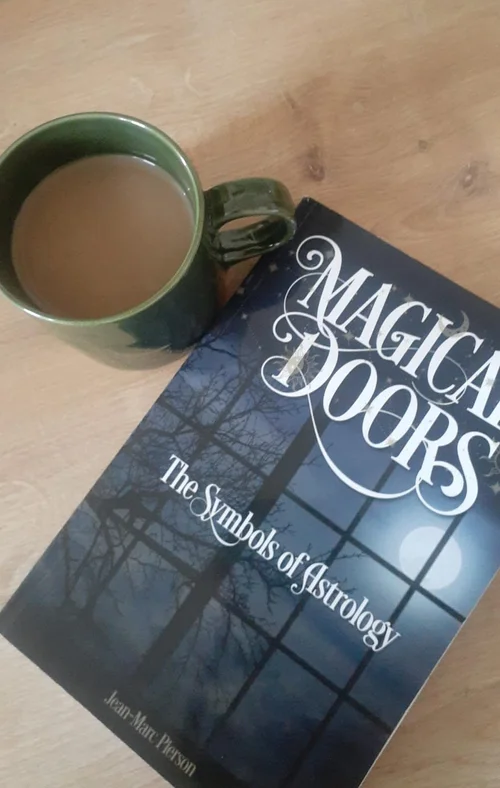Two minds, one fight. Mercury and Jupiter ()

Imagine you are a bird. You have two central preoccupations.
One is picking berries or insects for food. You need to be precise. You can’t just pick around in a blur and hope to be lucky. You need a clear focus. Evaluation of distance, details…
Your other central preoccupation is to be ready to escape.
Predators may attack from above, from below, from North, South, East or West. If your bird business coach has told you to “focus, focus, focus on the berries you deserve” you’re dead.
You need unfocused attention. You need a global perception of the world around you to notice when something moves. You may also notice other bushes with berries and make a mental note to go there next.
Every time you focus on the berry you’re about to pick, you’re like an antelope drinking at the water hole. You may not see the lions waiting in ambush. You better be quick. You reverse to peripheral vision and unfocused attention, open to detect signs of suspicious activity, you pick another berry… you don’t want to miss the cat.
These two modes of attention are expressions of the two cerebral hemispheres. Not only human brains have differentiated left and right cerebral hemispheres.
I’ve been reading Ian McGilchrist’s book: The Master and his emissary. For astrologers, this book can be renamed: “Jupiter and Mercury”. It’s a gold mine for understanding our two minds and the great divide between them.
Ian Mc Gilchrist is a neuroscientist, a psychiatrist and a philosopher.
He starts his book saying: “Forget everything you believe you know about the right and the left brain”.

His point is that the question of their difference is not “What are they doing?” but “How are they doing it?”
Both cerebral hemispheres are involved in whatever we do. What matters is that they are doing it in different ways. One way to look is efficient and practical: if you are a bird, it allows you to pick insects and berries; the other way allows you to know where you are and what’s going on.
Mc Gilchrist borrows a little tale from Nietzsche to make his point and give the title to his book: there was a wise and generous master who ruled a small but prosperous domain. His people grew in number, his domain became bigger. He couldn’t supervise everything himself anymore. He had to delegate his power and trust his emissaries.
However, the cleverest of his ministers betrayed his master’s trust. The emissary came to see himself as the master. He didn’t see the point of his master’s generosity. The domain became a tyranny, and eventually collapsed in ruins.
The emissary, according to Ian McGilchrist, is the left cerebral hemisphere, the one that has been called rational and logical. The master is the right cerebral hemisphere. This one is immersed in life as it flows. It sees the forest rather than the tree. For us, these two are Mercury and Jupiter.
Imagine. The Mercury of the bird has had enough of this habit of losing focus again and again. It could eat ten times as many berries if only it was able to increase its attention span. It despises itself for being such a dreamer. Cats are superstitions. God is a fairy tale. In this reality there are only twigs and berries. To be a winner, all you need is to be precise. Focus. Control. Never let go.
Let’s leave birds alone.
As humans, we have our own berries. Our science and technology make us the masters of the world. Nature is our slave. We are exhausting the earth. We abuse our own bodies. We are prisoners of our hyperactive minds. Sometimes we break down.
According to Ian McGilchrist, our modern/postmodern culture shares characteristics with schizophrenia, and schizophrenia with troubles observed when lesions in the right cerebral hemisphere gives the left cerebral hemisphere the monopoly of mental activity.
Thanks Mercury, damned trickster.
We can build computers but we don’t know who we are.

Neuroscientists can’t explain consciousness.
The meaning of life is but the title of a collection of rejoicing absurdities by the Monty Pythons.
We are lost, and we prefer not to think about it. Keep busy.
On the astrological front, how many times have I come across students mentioning a particular placement entirely out of context and asking: “What does this mean exactly?”
The word “exactly” is so typical of the demand of the berry picking worldview. It’s as if you were asking, “There is a slope, what does it mean exactly?” A slope doesn’t mean anything, and especially not “exactly”, out of the context of the mountain! Or maybe it’s the only slope you’ll find ten miles around?
If you’re riding a bicycle, your experience of it will be very different if you’re going uphill or downhill, and if you’re wondering whether to build your house there, it may be the same slope, but not the same life. Every time there is a context to take into account.
With the emissary getting rid of the master, you may get excited to know that the slope is fifteen percent steep, but you have no idea whether you’re climbing a mountain, riding a bicycle downhill or choosing a terrain to build a home.
This mental attitude is silly, but to talk about this silliness, I needed to use the slope as a metaphor, and you need your right brain to understand it. In this meaning-rich context, does it really matter if it’s fifteen percent rather than twelve?
The Moon, the Sun, Cancer, Leo, Capricorn, the Eastern horizon… nothing means anything “exactly”.
Symbols are the ultimate way to think in pictures. They were not born from great minds like logic from Aristotle’s. They are not the result of conscious efforts to measure, classify, give clear definitions and formulate coherent theories.
Symbolic language and analogical thinking are born from our direct experience of life. Like the fish of Pisces, we have been immersed in it for aeons. Our right brain is in touch with life as it flows, never twice the same river, but still knowable as it is. Our right brain registers a complex web of relationships evolving all around us, and within.
The psyche is a sea of images reflecting this intimate and direct knowledge. It’s pre verbal, pre rational, pre intellectual. It’s like knowing air because we’re breathing. We may have no idea about the percentage of oxygen, but knowledge of what it does when we come back to the surface after some time swimming under the water. We have knowledge of the wind when it blows and of its power in our sails. The zodiac reflects this kind of knowledge.
To understand symbols and read charts, we need to let go of our berries, of our urges to grasp and hold, let go of our rational thinking if only for a moment, and just remember how we see and feel, when we are not thinking compulsively.
What does the Rising Sun inspire us? How do we feel about rams, bulls or twins? What belongs to the ram family, what to the bull’s and what to the twin’s, in the world we are currently contemplating?
Symbols have various meanings, some of them can be downright opposites. Fire may mean hell, but it may also mean love, violence, presence of God or cooking. Jupiter, the holistic mind, doesn't mind: nothing has to make sense out of a context. It’s not like 2 + 2, which is 4 in all cases and even in the absence of any case.
Symbols are complex, seem paradoxical at times but are as familiar as being ourselves. Now, to what extent do we know ourselves?
To understand, the way is contemplation.
Becoming calm like the surface of a lake in the absence of wind.
Daydreaming, meditating…

Trying to walk in our ancestors’ shoes. A ram or a bull may mean more to a shepherd than to us. But we can imagine.
Coming back to Mercury, asking questions like “Where is the ruler of the Ascendant? In what signs and houses are the luminaries? Any tight aspects to them? Any planets conjunct angles in this chart? Where are the nodes and their rulers?...”
Once the general architecture of a chart is seen, coming back to the Jupiterian mind. Beyond what we have learned… What images come to the surface? How do they interact in a fluid mind? It doesn’t matter if nothing is certain, letting imagination live is inviting inspiration.
Inspiration may not come running like a dog to the word “treat”, we really need to let go of our fierce desire to control.
If we ask to Spirit, to invisible friends or to our own subconscious mind for help, we don’t command, we say “please”, and if we don’t forget the spirit of “thank you” for what is revealed, more may come another day.
At the core, it’s divination.

Jean-Marc Pierson
When I write about astrological symbols, my aim is to conjure up their spirit and inspire my readers to be able to do the same. Understanding the spirit is the deepest understanding. Cookbook definitions can only fall short of that.
When I teach, that’s what I wish students to be able to do.
To learn more, here is the way to the homepage
Thank you!
Share
Written by Jean-Marc PiersonOn April 23, 2024Taurus Spirit. →
Comments (0)
Newest First
Preview Post Comment…
POWERED BY SQUARESPACE
Editing ‘Two worlds, two minds, a fight: Mercury and Jupiter’

Comments
Post a Comment